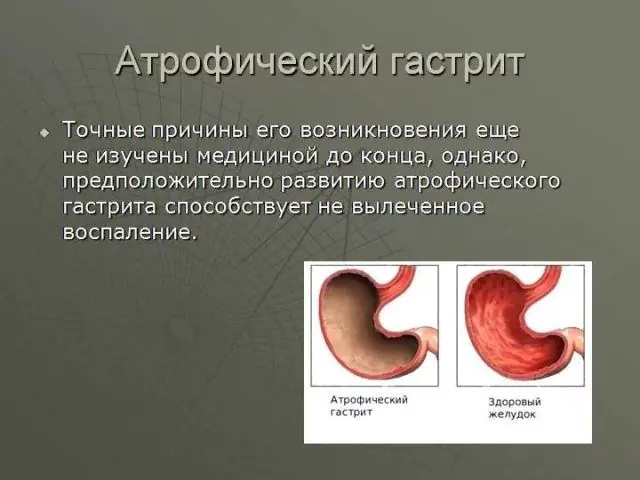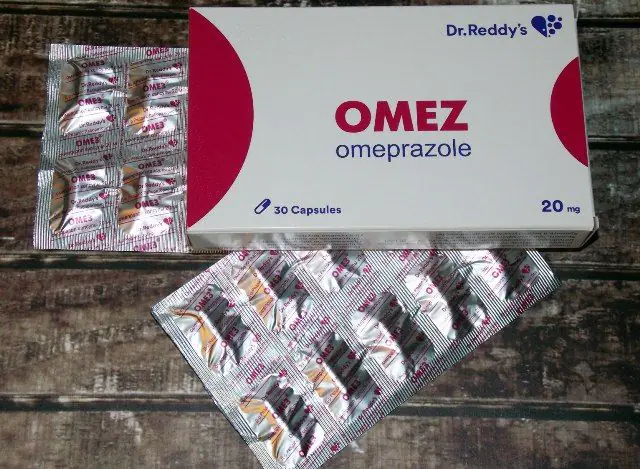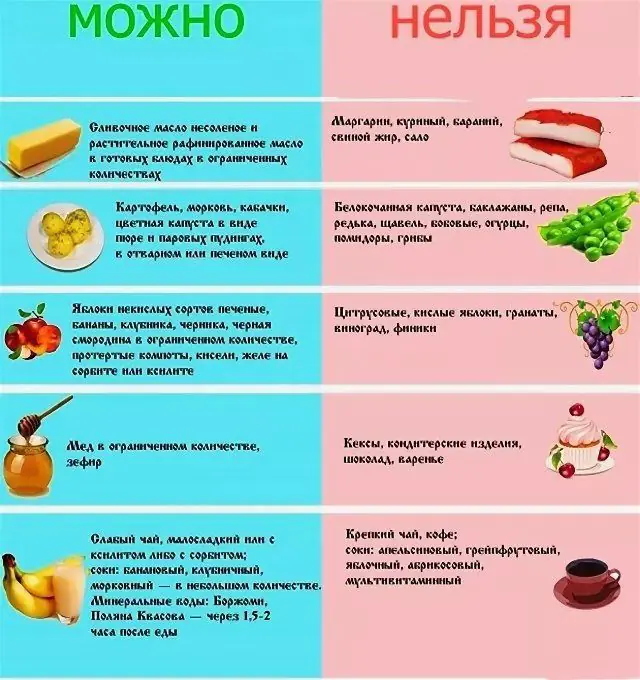
Description and causes of atrophic gastritis. Main symptoms and diagnosis. Methods of treatment.
The content of the article:- Reasons and forms
- Symptoms and diagnosis
- Treatment of atrophic gastritis
- Medicines
- Folk remedies
- Diet
Atrophic gastritis is a chronic inflammatory pathology that affects the gastric mucosa. Progresses slowly, occurs against the background of a long course of the infectious process provoked by Helicobacter pylori infection.
Causes and forms of atrophic gastritis

Atrophic gastritis is a pathological condition in which there is a decrease in the acid-forming function of the stomach. This is a precancerous condition in which patients complain of heaviness and dull pain in the stomach, nausea, heartburn, and dyspepsia. Chronic progressive inflammatory process leads to a decrease in the number of gastric glands.
The risk group includes people over 40 years of age who work in hazardous enterprises, take medications uncontrollably (especially those with anti-inflammatory and analgesic effects), have asocial and psycho-emotional disorders, have a hereditary predisposition to gastritis, and abuse heavy, fatty foods.
Atrophic gastritis is a multifactorial condition that develops as a result of hereditary predisposition, under the influence of infectious pathogens, as well as autoimmune diseases. This form of the disease manifests itself in patients who have not received quality treatment for superficial gastritis.
There are external and internal factors - the causes of atrophic gastritis. External factors include exposure to toxic substances, alcohol abuse, smoking, poor diet, poor food quality, excessive consumption of fatty, salty, and smoked foods.
Among the internal ones, long-term exposure to Helicobacter pylori infection, disruption of the process of restoration of the gastric epithelium, pathologies of the thyroid gland, and impaired blood supply to the gastrointestinal tract are noted.
There are several forms of atrophic gastritis:
- Atrophic antral. It affects areas of the gastrointestinal tract that are located in the space between the stomach and duodenum. Lack of timely treatment leads to the spread of inflammation to other parts of the gastrointestinal tract.
- Subatrophic. Primary gastritis, in which the gastric epithelium atrophies.
- Multifactorial. The most severe form, affecting all parts of the gastrointestinal tract.
- Focal atrophic. This form often leads to partial damage to the epithelial layer. Pepsin and hydrochloric acid are synthesized in smaller quantities. The formation of inflammatory plaques on the walls of the stomach is observed. There are complaints of moderate discomfort, pain in the abdominal area after eating, heartburn, nausea and heaviness in the abdomen.
- Diffuse. It is a precancerous condition in which epithelial cells are transformed. They are the ones who participate in the synthesis of hydrochloric acid, and if their functioning is disrupted, digestive processes slow down.
- Erosive atrophic. Accompanied by the formation of ulcerative formations on the gastric epithelium, which provoke the development of gastric bleeding. It has a sluggish course and goes unnoticed for a long time.
- Atrophic hyperplastic. In this case, the epithelium of the stomach grows and polyps form. Accompanied by a decrease in the acidity of gastric juice, gradually the acid is completely replaced by mucous formations.
The prognosis depends on the degree of atrophic gastritis and is aggravated for patients in older age groups. Modern methods of drug treatment, correction of diet and giving up bad habits can slow down the course of the disease. The lack of high-quality, timely therapy is fraught with the following complications of atrophic gastritis: gastric ulcer, weakened immune system, chronic inflammation.
Symptoms and diagnosis of atrophic gastritis

The disease develops slowly, and for a long time the symptoms of atrophic gastritis remain without proper attention.
The disease affects the bottom of the stomach, after which it gradually moves to the mucous membranes. Its functional activity gradually decreases, the patient experiences belching, decreased appetite, and complaints of nausea, heaviness in the abdomen, and increased salivation. Bacterial overgrowth syndrome causes rumbling, bloating, and unstable stools. The patient does not tolerate dairy products well, constant diarrhea occurs, and body weight decreases sharply.
With atrophic gastritis, the absorption of vital vitamins is impaired: B9, B12. As a result of the development of anemia, the tongue becomes smooth, varnished, and “polished.” Metabolic processes are disrupted, complaints of general weakness and impaired performance arise. Hair and nails become dry and brittle. Even with minor physical exertion, shortness of breath and discomfort in the chest are bothersome.
Since the initial stage of the inflammatory process in the mucous membranes is asymptomatic, patients rarely seek medical care in a timely manner. In this case, there is a transformation of the acute pathological process into a chronic one and, over time, into an atrophic one. As the disease progresses, symptoms intensify and complete atrophy of the digestive glands is observed.
Note! The clinical picture depends on the form and severity of the disease.Increased acidity of gastric juice leads to constant irritation of the mucous membrane, which becomes inflamed, resulting in the formation of ulcerative lesions. The disorder is accompanied by a burning sensation in the epigastric region, pain that intensifies in a state of hunger and at night, hungry nausea, sour belching, appetite disturbances, and increased gas formation.
With low acidity of gastric juice, the patient is bothered by a dull, aching pain in the stomach, loss of weight and appetite, flatulence, metallic taste in the mouth, constipation, a feeling of weakness, and the presence of spots before the eyes.
During the diagnosis of atrophic gastritis, the doctor conducts a face-to-face examination and oral questioning of the patient, as well as a comprehensive diagnosis using laboratory and instrumental research methods. Gastroscopy allows you to identify foci of inflammation, but does not determine the extent of its spread. To correctly assess the area of altered tissue, a biopsy is required, as well as gastroscopy with contrast. Endoscopic examinations are less informative and are used in isolated cases.
Patients are recommended to undergo ultrasound diagnostics of the gastrointestinal tract. To determine the acidity of gastric juice, pH measurements are used and acidity levels are measured over a 24-hour period. If there is a suspicion of a tumor process, magnetic resonance or computed tomography is used. In order to detect Helicobacter, PCR diagnostics, a breath test, and a blood test are required to identify antibodies with the pathogenic microorganism.
Methods for treating atrophic gastritis
The main task of treating the disease is to prevent further spread of the inflammatory process and transformation into a malignant neoplasm. The gastroenterologist makes the decision on how to treat atrophic gastritis based on the results of a comprehensive diagnosis, individually for each patient. The form of the pathological process, localization and degree of spread are taken into account. Patients are advised to correct their diet, use medications, and normalize their psycho-emotional state. A course of physiotherapy procedures is prescribed: electrophoresis with drugs, magnetic therapy, thermal treatment for the abdominal area. To reduce the likelihood of repeated exacerbations of atrophic gastritis, spa treatment is indicated.
Medicines for atrophic gastritis

Omez for the treatment of atrophic gastritis
When selecting drugs for atrophic gastritis, the state of the secretory function of the gastrointestinal tract, the patient’s age, the individual characteristics of the body, and the presence of concomitant disorders are taken into account.
The general scheme of drug treatment for atrophic gastritis includes the use of the following drugs recommended by a doctor:
- Buscopan. A drug that reduces the severity of pain and helps reduce the secretory function of the digestive system. Available in the form of rectal suppositories and tablets for internal use. It is recommended to take 1-2 tablets. twice a day, suppositories are inserted into the rectum before bedtime. Well tolerated; in isolated cases, dryness and redness of the skin, arrhythmia, urticaria, and eczema were reported. The price is 115 rubles. (45 UAH). The drug has no analogues.
- Acidin-pepsin. A replacement therapy drug when the body's own production of pepsin and hydrochloric acid is impaired. Tablets based on betaine and pepsin, which increase the production of gastric juice and restore the digestion process. The drug is contraindicated in patients with gastric and duodenal ulcers, erosive gastroduodenitis, and pregnant women. The medicine is taken during or after a meal, 2 tablets up to 4 times a day, previously dissolved in water. Cost - 90 rubles. (35 UAH). Analogues: natural gastric juice in bottles (100 ml).
- Cerucal. A drug based on metoclopramide, which stimulates intestinal motility. Available in the form of tablets for internal use and solution for injection. Helps cope with nausea and vomiting; tablets are used before diagnostic studies of the gastrointestinal tract. Take 1 tablet up to 3 times a day. Cerucal is a symptomatic remedy that should not be used regularly. In case of overdose, drowsiness, confusion, irritability, and convulsions are observed. The cost is 665 rubles. (260 UAH). Analogue - Metoclopramide.
- Omez. An omeprazole-based drug that suppresses the production of hydrochloric acid. This is a proton pump inhibitor that exhibits a therapeutic effect 1 hour after administration and maintains it throughout the day. Dosage forms: capsules for internal use, lyophilisate powder for the preparation of infusion solutions. This is an effective anti-ulcer agent that is used in the treatment and prevention of re-development of ulcerative lesions. After discontinuation of Omez, a restoration of the secretory activity of the gastric glands is observed after 24-72 hours. Price - 150 rub. (60 UAH). Analogues: Omeprazole, Gasec, Bioprazole, Zolser.
- Creon. An enzyme preparation based on protease, lipase, amylase, pancreatin, which stimulates secretory function. Used for disorders of the gastrointestinal tract, obstructions, bacterial overgrowth syndrome. Not used for individual intolerance to active substances, exacerbation of chronic pancreatitis. Cost - 260 rubles. (100 UAH). Analogues: Creon 10000, Creon 25000.
- Amoxicillin. An antibacterial medicine that is recommended for infectious diseases. To enhance the therapeutic effect, Amoxicillin is combined with Metronidazole. Price - 100 rub. (40 UAH). Analogue - Amoxil.
- Gastal. An antacid drug that suppresses high acidity and helps cope with heartburn. The price of the product is 170 rubles. (65 UAH). The possibility of using Maalox and Rennie is being considered as analogues.
Folk remedies against atrophic gastritis

Cabbage juice for atrophic gastritis
Treatment of atrophic gastritis with folk remedies is effective in the early stages of the disease. Traditional medicine recipes are combined with the use of medications, diet, and physiotherapy. Before using them, it is recommended to consult with your doctor.
Effective folk remedies for treating atrophic gastritis:
- To reduce the manifestations of the disease, it is recommended to drink juices: sauerkraut, potato, cabbage. The product is taken 1/4 cup three times a day 30 minutes before meals. The course of treatment is 2 weeks, after which you need to take a break. The juice of fermented (fermented) food has a beneficial effect on the intestinal microflora.
- To prepare a decoction of plantain, pour a tablespoon of the raw material into 0.5 liters of boiling water and leave for 15 minutes. Drink 1/2 cup 2-3 times a day before the main meal.
- Finely chop St. John's wort (inflorescences), place in a small thermos, pour boiling water. Leave for 3 hours, filter, take 100 ml three times a day for atrophic gastritis, half an hour before meals.
- To stimulate the secretion of hydrochloric acid, it is recommended to use a herbal decoction based on fennel, plantain, and wormwood. All components are mixed in equal parts, poured with water and boiled in a water bath for 15 minutes. The resulting drink is cooled, filtered and taken 30 ml three times a day. The course of treatment is 1 month, after which it is necessary to take a break.
- Olive oil, lemon juice and honey are mixed and placed in a glass container. Take 1 tablespoon three times a day before the main meal. The described components protect the mucous membrane of the gastrointestinal tract and accelerate the process of restoration of damaged tissues. The resulting product should be stored in a dark, cool place and mixed thoroughly before each use.
- To speed up the regeneration process and reduce the severity of the inflammatory process in atrophic gastritis, the use of sea buckthorn oil is indicated. The drug is taken 10 ml before meals for 1 month. Next, take a break, after which the course can be repeated. Sea buckthorn oil creates a protective shell, softens and heals ulcerative lesions. Suitable for patients of all age groups.
- When the acidity of gastric juice increases, the use of a herbal mixture based on chamomile, marsh grass, and calendula is recommended. Mix all components in equal proportions, pour boiling water, leave for 20 minutes. Strain, consume 100 ml twice a day.
- To reduce pain in the abdomen with atrophic gastritis, flax seeds are heated in a frying pan, poured into a bag made of natural fabric and applied to the affected area of the epigastrium. The product is left to act until the bag cools completely.
- In case of chronic disease, aloe juice is mixed with honey and consumed 1 tablespoon three times a day for a month. The course of therapy can be carried out several times a year. To enhance the therapeutic effect, you can add linseed or sea buckthorn oil to the mixture.
- Coconut water and coconut oil have a pronounced anti-inflammatory effect; they are recommended to be used daily on an empty stomach. Coconut accelerates regeneration and provides the body with essential vitamins, healthy fatty acids, and microelements.
Vegetable juices for atrophic gastritis must be consumed immediately after preparation. They retain their healing properties for 10-15 minutes, after which they become unusable.
Traditional medicine suggests drinking carrot juice or finely grated carrots before breakfast. Flax seeds, previously crushed in a coffee grinder, or seed-based jelly have a pronounced therapeutic effect.
Important! If in the process of alternative treatment of atrophic gastritis the patient’s well-being worsens or accompanying symptoms appear, then stop using home methods and consult a doctor.Diet for atrophic gastritis

Nutritional therapy for atrophic gastritis is an essential element of complex therapy. Food should be gentle so as not to injure the affected epithelium. Frequent meals, in small portions, are indicated. Food is finely chopped, steamed or boiled.
Patients should avoid eating excessively spicy or hot foods. The consumption of fatty, fried, spicy, sour, smoked, soda, and simple carbohydrates is contraindicated.
To reduce the severity of the inflammatory reaction, it is recommended to consume liquid chlorophyll and add a large amount of leafy greens and lettuce to the diet.
In the menu for atrophic gastritis, it is prohibited to include strong, rich meat and fish broths, canned food, sausages, spicy seasonings, fatty meat and fish, mushrooms, baked goods, and baked goods made from yeast dough.
After the patient’s well-being returns to normal, diluted juice can be taken: cabbage, potato, cranberry. Eating fresh fruits is not recommended; introducing a small amount of bananas into the diet is acceptable.
Note! A diet for atrophic gastritis involves quitting smoking and drinking alcohol.How to treat atrophic gastritis - watch the video:
To prevent atrophic gastritis, timely detection and treatment of Helicobacter infection is recommended. It is also necessary to follow a daily routine, monitor your diet, wash your hands after going outside and visiting the restroom to prevent infection. At the first signs of atrophic gastritis, you should refrain from self-medication and seek advice from an experienced gastroenterologist.



